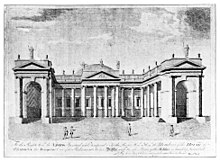This article needs additional citations for verification. (June 2017) |
Parliament of Ireland Parlaimint na hÉireann | |
|---|---|
 | |
| Type | |
| Type | |
| Houses | House of Lords House of Commons |
| History | |
| Established | 1297 |
| Disbanded | 31 December 1800 |
| Preceded by | Gaelic Ireland |
| Succeeded by | UK Parliament |
| Leadership | |
The Earl of Clare (last) | |
John Foster (last) | |
| Elections | |
| Ennoblement by the monarch or inheritance of a peerage | |
| First past the post with limited suffrage | |
| Meeting place | |
 | |
| Parliament House, Dublin | |
| Footnotes | |
| ----
See also: Parliament of Great Britain | |
The Parliament of Ireland (Irish: Parlaimint na hÉireann) was the legislature of the Lordship of Ireland, and later the Kingdom of Ireland, from 1297 until the end of 1800. It was modelled on the Parliament of England and from 1537 comprised two chambers: the House of Commons and the House of Lords. The Lords were members of the Irish peerage ('lords temporal') and bishops ('lords spiritual'; after the Reformation, Church of Ireland bishops). The Commons was directly elected, albeit on a very restricted franchise. Parliaments met at various places in Leinster and Munster, but latterly always in Dublin: in Christ Church Cathedral (15th century),[1] Dublin Castle (to 1649), Chichester House (1661–1727), the Blue Coat School (1729–31), and finally a purpose-built Parliament House on College Green.[3]
The main purpose of parliament was to approve taxes that were then levied by and for the Dublin Castle administration. Those who would pay the bulk of taxation, namely the clergy, merchants, and landowners, also comprised the members. Only the "English of Ireland" were represented until the first Gaelic lords were summoned during the 16th-century Tudor reconquest. Under Poynings' Law of 1495, all Acts of Parliament had to be pre-approved by the Irish Privy Council and English Privy Council. Parliament supported the Irish Reformation and Catholics were excluded from membership and voting in penal times. The Constitution of 1782 amended Poynings' Law to allow the Irish Parliament to initiate legislation. Catholics were re-enfranchised under the Roman Catholic Relief Act 1793.
The Acts of Union 1800 merged the Kingdom of Ireland and Kingdom of Great Britain into the United Kingdom of Great Britain and Ireland. The parliament was merged with that of Great Britain; the united Parliament was in effect the British parliament at Westminster enlarged with a subset of the Irish Lords and Commons.
- ^ a b Richardson 1943 p.451
- ^ Bray 2006 pp.18, 52; "[1537 (28 Hen. 8) c. 12] An Act against proctors to be any member of the Parliament. Rot. Parl. cap. 19.". The Statutes at Large Passed in the Parliaments Held in Ireland. Vol. 1: 1310–1612. B. Grierson. 1765. pp. 102–103.
- ^ Moody, Theodore William; Martin, Francis X.; Byrne, Francis John (2005). A New History of Ireland: Maps, genealogies, lists. Clarendon Press. p. 605. ISBN 9780198217459.
Cite error: There are <ref group=note> tags on this page, but the references will not show without a {{reflist|group=note}} template (see the help page).